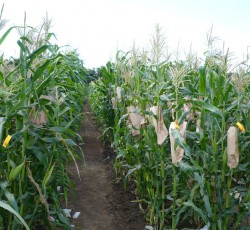ชื่อเรื่อง(ไทย)
การสร้างพันธุ์ข้าวโพดไร่พันธุ์ลูกผสมเดี่ยวสำหรับเกษตรกรในเขตภาคเหนือของไทยชื่อเรื่อง(Eng)
Development of Corn Single Cross Hybrid for Farmer in Northern Thailandชื่อผู้วิจัย(ไทย)
เสกสรร สงจันทึก สุรินทร์ ดีสีปาน ธนวัฒน์ รอดขาว และสุกิจ ติดชัยชื่อผู้วิจัย(Eng)
SEAKSAN SONGJUNTUK, SURIN DEESRIPAN, THANAWAT RODKAW AND SUKIJ TIDCHAIหน่วยงาน
ฝ่ายปรับปรุงและพัฒนาพันธุกรรมพืชและสัตว์ สำนักวิจัยและส่งเสริมวิชาการการเกษตรบทคัดย่อ
การสร้างพันธุ์ข้าวโพดไร่ลูกผสมเดี่ยว โดยวิธีผสมพันธุ์แบบพบกันหมด (Diallel Cross Method I, Model I) ได้ทำการวิจัยข้าวโพดต่อเนื่อง 2 ฤดูปลูก ตั้งแต่ปี พ.ศ. 2554-2555 ที่สาขาพืชไร่ คณะผลิตกรรมการเกษตร มหาวิทยาลัยแม่โจ้ เพื่อพัฒนาและคัดเลือกพันธุ์ข้าวโพดไร่ลูกผสมที่ให้ผลผลิตและคุณภาพดีกว่าพันธุ์มาตรฐาน โดยคัดเลือกสายพันธุ์ผสมตัวเอง 2, 6 และ 9 ชั่ว (S2, S6 และ S9) มาจำนวน 6 สายพันธุ์ ผสมพันธุ์แบบพบกันหมด ได้พันธุ์ลูกผสมเดี่ยว 30 คู่ผสม นำมาเปรียบเทียบผลผลิตเบื้องต้นในฤดูต้นฝน พ.ศ. 2555 โดยวางแผนการทดลองแบบ 7x7 double lattice 2 ซ้ำ ผลการทดลองพบว่า พันธุ์ลูกผสม (DK9955S2-2-1 x Pac0390179S6-1-1-1-1-1-2)F1, (NT6346S2-4-1 x Pac0390179S6-1-1-1-1-1-2)F1, (B80S2-1-1 x DK9955S2-2-1)F1, (Pac0390179S6-1-1-1-1-1-2 x NT6346S2-4-1)F1 ให้ผลผลิตน้ำหนักเมล็ดที่ความชื้น 14% 1,548, 1,528, 1,513 และ 1,508 กิโลกรัม/ไร่ ตามลำดับ ซึ่งให้ผลผลิตสูงกว่าพันธุ์มาตรฐาน CP888 (1,438 กิโลกรัม/ไร่) ถึง 7.6, 6.3, 5.2 และ 4.9% จากการประเมินสมรรถนะการผสมทั่วไป (GCA) ของสายพันธุ์พ่อแม่ โดยวิธีวิเคราะห์ Diallel Cross Method I พบว่า สายพันธุ์ Pac039017S6-1-1-1-1-1-2, NT6346S2-4-1-1 และ DK9955S2-2-1-1 ให้ค่า GCA เป็นบวก ของลักษณะผลผลิตน้ำหนักเมล็ดที่ความชื้น 14% (+142.00, +11.44 และ +2.94) จึงคัดเลือกสายพันธุ์ทั้งสามไว้ใช้เป็นสายพันธุ์ทดสอบในโครงการปรับปรุงพันธุ์ข้าวโพดไร่ของมหาวิทยาลัยแม่โจ้ สำหรับพันธุ์ข้าวโพดไร่ที่ผ่านการคัดเลือกทั้งสี่พันธุ์จะได้ขยายสายพันธุ์พ่อแม่ และผลิตเมล็ดพันธุ์ลูกผสมชั่วที่ 1 เบื้องต้น แล้วนำออกมาเปรียบเทียบพันธุ์แบบมาตรฐาน และในไร่เกษตรกรต่อไป
คำสำคัญ: ปรับปรุงพันธุ์ ข้าวโพด ลูกผสมเดี่ยว
Abstract
In this study, series of 2 seasonal experiments were conducted from 2011-2012 at the Department of Agronomy, Faculty of Agricultural Production in Maejo University. In order to develop and select corn single cross hybrid. The selected S2, S3 and S9 lines were dialleled cross to develop 30 corn single cross hybrids. The single cross hybrids, parents and check varieties were preminarily compared for their yield and quality using 7x7 double lattice design during the 2012 early rainy season. The results indicated that single crosses (DK9955S2-2-1 x Pac0390179S6-1-1-1-1-1-2)F1, (NT6346S2-4-1 x Pac0390179S6-1-1-1-1-1-2)F1, (B80S2-1-1 x DK9955S2-2-1)F1, and (Pac0390179S6-1-1-1-1-1-2 x NT6346S2-4-1)F1 produced high grain weights at 14% moisture content by 1,548, 1,528, 1,513 and 1,508 kg/rai. The 4 single cross hybrids gave better grain weight than CP888 (check) by 7.6%, 6.3%, 5.2% and 4.9% respectively. The estimates of the general combining ability (GCA) for the trait was then calculated using diallel cross method I analysis. Results showed that three lines; Pac 039017S6-1-1-1-1-1-2, NT6346S2-4-1-1 and DK9955S2-2-1-1 gave high positive GCA effects for grain weights at 14% moisture content by +142.00, +11.44 and +2.94. The three lines were then selected as testers for the corn breeding program in Maejo University. It is suggested that parent seeds of the four corn F1 hybrids should be multiplied and should prefatorily produced the F1 hybrid seed and the compared with other commercial hybrids in standard yield trials as well as in farmer.
Keywords: breeding, corn, single cross, hybrid

